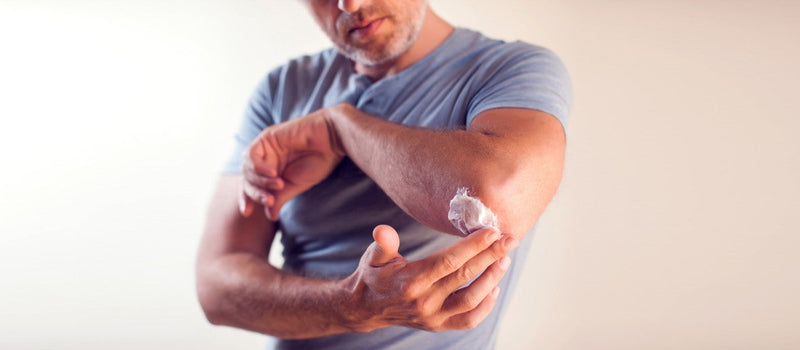

Skin disorders are a common complication of diabetes. The development of diabetes skin disorders means that your blood sugar (glucose) levels are too high. Sugar leads to inflammation, which can cause skin breakouts and other inflammatory conditions. Common skin problems resulting from diabetes include:
· Dry itchy skin: High blood glucose levels may cause greater loss of fluid from the body leading to dry skin on the legs, elbows, feet and other areas.
· Bacterial infections: Diabetes increases the risk of bacterial infections. Infections can lead to swollen, red, and painful skin, which requires antibiotics for treatment.
· Fungal infections: Candida albicans is a fungal infection that can develop in people who have diabetes. It is a yeast-like fungus that can create itchy rashes of moist, red areas surrounded by tiny blisters and scales.
High blood sugar levels also can affect the nerves in your skin, resulting in poor circulation and reduced sensation or diabetic neuropathy. Since neuropathy can cause numbness, if you have diabetes, you might not feel a foot injury, cut or even a blister that could result in an ulcer. Foot ulcers often lead to hospitalization.
Other diabetes skin disorders include:
· Acanthosis nigricans (AN): A skin condition characterized by darkening and thickening of the skin that occurs in the folds of the skin.
· Diabetic dermopathy: Brown, scaly patches often on the front of both legs.
· Disseminated granuloma annulare: A skin disorder that most often causes a sharply defined ring-or arc-shaped skin area. Rashes occur on fingers and toes.
· Eruptive xanthomatosis: Happens when diabetes is out of control. Demonstrates as firm, yellow pea-like enlargements in the skin, which have red halos and may itch.
· Digital sclerosis: Tight, thick, waxy skin on the backs of hands.
· Diabetic blisters: A rare condition that features painless blisters that form on the back of hands and feet and on legs and forearms.
· Diabetes foot syndrome: Foot ulcers associated with neuropathy and ischemia (deficient supply of blood to the body) and infection.
Role of exercise in diabetes skin disorders
Exercise is good for your heart, lungs, and state of mind. Regular exercise also can lower blood pressure and triglyceride (fat) levels. Harvard Health also points out that for people with diabetes, exercise has the added benefit of lowering blood glucose levels and boosting the body’s sensitivity to insulin to counter insulin resistance. [1]
Exercise is also key to healthy skin. It improves circulation, which can help carry oxygen and nutrients to your skin, as well as other working cells throughout your body. In addition to providing oxygen, blood flow also helps carry away waste products, including free radicals, from working cells. By increasing blood flow, exercise helps flush cellular debris out of your system.[2]
Low impact exercise and diabetes
Low-impact exercises are gentle on the joints and can be easily incorporated into your daily routine. Before engaging in any exercise, however, consult with your healthcare provider especially if you have any underlying health conditions.
Walking: Exercise can be as simple as walking. Walking is effective in promoting weight loss and maintenance, and in improving glycemic control. It also helps to improve balance, lower blood pressure and stress, and build bone and muscle strength. And the risk of injury from walking is low. All you need are comfortable shoes with good support. If you work and do not think you have time for a longer walk each day, try walking briskly for 10 minutes after each meal. Three 10-minute spurts of exercise are as beneficial as one 30-minute session.[3]
Gardening: Gardening is another simple way to stay active and relieve stress at the same time. If you live in an apartment or just have a small backyard, get a plot in a community garden. Community gardening puts you in touch with others in your neighborhood. Studies also have confirmed that people who garden consume more fiber-rich foods.[4]
Exercise videos: There is a wealth of online videos that provide instruction on everything from low-impact aerobics to resistance and strenuous cardio routines to Tai Chi. Check them out.
Cycling: If you have a bike, get on it. Cycling is a low-impact exercise with benefits if you have diabetes, especially if you have neuropathy, which can cause joint paint. Cycling minimizes strain on your joints.
Yoga: Yoga is a means to balance and harmonize the body, mind, and emotions. A recent scientific review points out that Yoga practice is useful in the management of various lifestyle diseases, including Type 2 diabetes. Incorporating yoga in daily life helps to attain glycemic control and reduces the risk of complications in people with diabetes.[5]
You will want to monitor your blood sugar levels before, during, and after exercise to ensure your blood sugar remains within a safe range and to prevent any complications. If you take insulin or other diabetes medications, your healthcare provider may recommend adjusting your dosage or timing to accommodate your exercise routine.[6]
Make exercise a key component of your diabetes management. It will help control blood sugar levels and reduce the risk of diabetes skin complications.
[1] “The importance of exercise when you have diabetes,” Harvard Health Publishing,” February 3, 2021. https://www.health.harvard.edu/staying-healthy/the-importance-of-exercise-when-you-have-diabetes
[2] Jaret, Peter, “Exercise for Healthy Skin,” WebMd, April 14, 2011. https://www.webmd.com/skin-problems-and-treatments/acne/features/exercise
[3] Kinnaird, Shelby, “5 Ways to Stay Active to Manage Type 2 Diabetes – Without the Gym,” healthline, August 25, 2020. https://www.healthline.com/health/type-2-diabetes/stay-active-without-the-gym
[4] “The Health Benefits of Gardening,” American Diabetes Association, Accessed March 15, 2025. https://diabetes.org/healthy-living/fitness/benefits-of-gardening
[5] Raveendran AV, Deshpandae A, Joshi SR. Therapeutic Role of Yoga in Type 2 Diabetes. Endocrinol Metab (Seoul). 2018 Sep;33(3):307-317. doi: 10.3803/EnM.2018.33.3.307. Epub 2018 Aug 14. PMID: 30112866; PMCID: PMC6145966. https://www.ncbi.nlm.nih.gov/pmc/articles/PMC6145966/
[6] “The Ultimate Guide to Diabetic Skin Care,” Care Clinic, Accessed March 15, 2025. https://careclinic.io/diabetic-skin-care/








